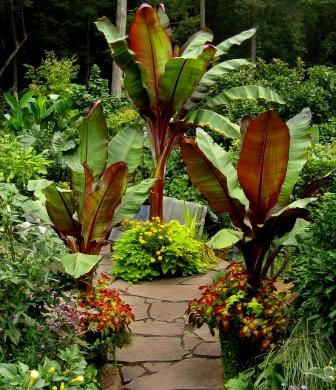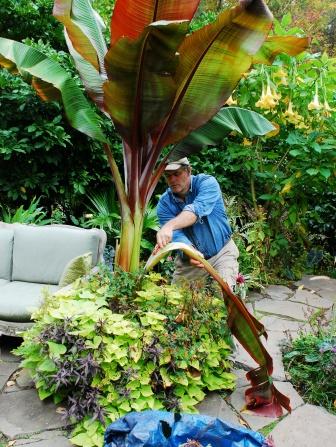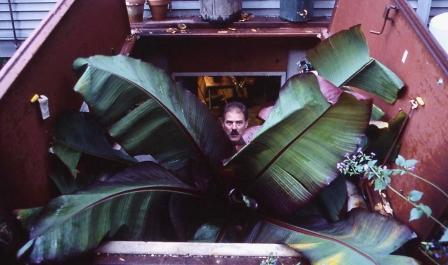OK, so I’m a world-class procrastinator. That meant that the dwindling light of the other day found me outside, desperately preparing tender plants for their winter hibernation. Frost was coming, and a lot of my favorite plants do NOT like frost. That meant they had to come in. I’ve grown bananas in the ground and in pots for years, and if I’ve heard this question once, I’ve heard it 1,527 times: “What do you do with those in the winter?” Well, this is what I do.
I begin in early September, backing off on watering (the only plants that get watered in my garden are those in pots and newbies). No more fertilizer. The idea is to slow their rampant growth. Then on the eve of a frost I’m out there with saw and shears in hand, lopping off the outer leaves. I cut them all the way down to the base. Since these plants are mostly water, cutting off a single leaf removes maybe 5 or more pounds from the plant’s weight. My goal is to reduce the plant’s huge bulk, but not its height. I know some folks slice off their bananas just above soil level, but my aim is to preserve the plant’s height, so it becomes more treelike with age. Bananas that get beheaded come back, but they are more shrubby. Anyway, I cut, cut cut, until I’ve removed maybe half the leaves–cutting too many will weaken the banana’s trunk enough for all those big leaves still up on top to make the too-spindly trunk fold over in transit or in storage.
With the plant trimmed back hard, I remove any companion plants and loosen the rootball at pot’s edge by sawing through the outermost roots with my garden knife, or hori-hori. Then I gently turn the pot on its side, and wrassle rootball and plant from the pot. Doing this operation while the pots on its side entails less lifting, so it saves my back. This is when its really handy to have the soil dry–much easier to move. Sometimes you really have to get up close and personal with the banana-you can see my feet pushing against the rim of the pot in this picture. It’s nice to have a helper for this, especially with larger plants-they can provide extra support to help keep the trunk from bending.
With the plant unearthed or debouched from its pot, I manhandle it down to the basement. (No I do not have dirty lip in this photo–that’s an old picture and I used to have a moustache).
Once there, I drag it across the floor and stuff it unceremoniously into a corner of our root cellar (that’s it in the very back of the corner)–a space 10 feet by about 12 that hosts most of my tropicals during winter. Temperatures range form about mid 40s to upper 50s, and they stay there with no light and no water. I give them virtually no attention whatsoever until May. I’ve learned my storage space is quite humid and provides the plants with enough moisture to get by. In a very dry space you might have to sprinkle a little water now and then. But basically I try to store these things very, very dry–too much moisture will cause rot or fungus. Remember, the plants are not growing, they are just clinging to life. And that’s just what they do until May when after the last frost I bring them, up cut them back hard up top–they look look just godawful at this point–repot, and start providing them water, fertilizer, heat, and sunlight and before long, they’re putting on a show.





